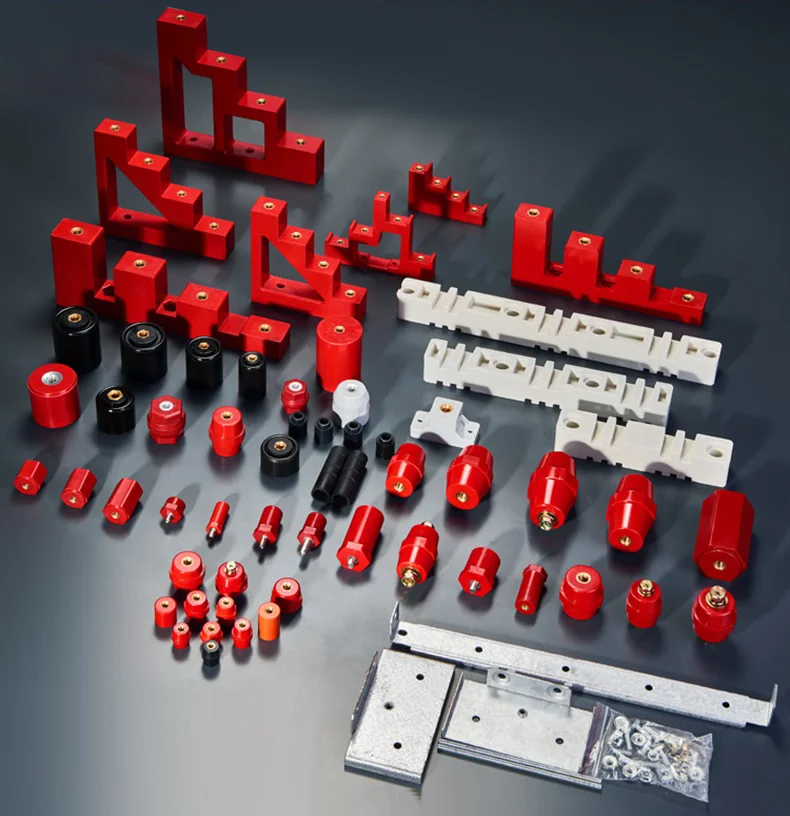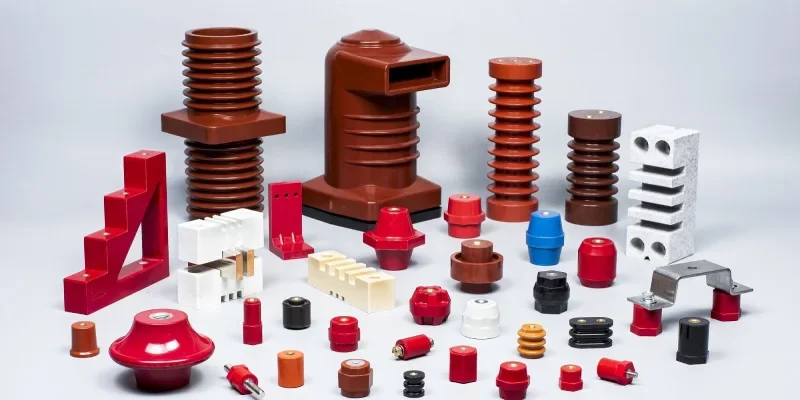A gyűjtősín-szigetelők az elektromos rendszerek kritikus elemeiként szolgálnak, elektromos szigetelést és mechanikai alátámasztást biztosítanak az áramvezető vezetékeknek. Gyártási folyamataik jelentősen fejlődtek, hogy megfeleljenek a modern energiaelosztó hálózatok követelményeinek, amelyek nagy megbízhatóságot, hőstabilitást és környezeti ellenállóképességet igényelnek. Ez a jelentés összefoglalja a gyűjtősínszigetelők gyártásának legújabb fejlesztéseit és hagyományos módszereit, kiemelve az anyagválasztást, a gyártási technikákat, a minőségellenőrzést és a környezetvédelmi szempontokat.

Anyagkiválasztás és előkészítés
Alapanyagok
A gyűjtősín-szigetelőket elektromos ellenállásra, mechanikai szilárdságra és hőstabilitásra optimalizált dielektromos anyagokból gyártják. A leggyakoribb anyagok a következők:
- Polimer kompozitok: Az üvegszállal erősített ömlesztett öntőanyag (BMC) és az üvegszállal erősített lemezes öntőanyag (SMC) könnyű súlyuk, nagy dielektromos szilárdságuk (~4 kV/mm) és hőállóságuk (140°C-ig) miatt dominálnak az alacsony és középfeszültségű alkalmazásokban.
- Porcelán: A nagyfeszültségű kültéri berendezésekhez előnyben részesített porcelán kivételes tartósságot és időjárásállóságot biztosít. Előállításához nagy tisztaságú timföldet használnak, amelyet 1200°C-ot meghaladó hőmérsékleten égetnek, hogy sűrű, nem porózus szerkezetet kapjanak.
- Epoxigyanták: A gyűjtősínek burkolására használt epoxi erős szigetelést és környezetvédelmet biztosít. A korszerű készítmények szilícium-dioxid töltőanyagokat tartalmaznak a hővezető képesség javítása és a CTE (hőtágulási együttható) eltérések csökkentése érdekében.
- Hőre lágyuló műanyagok: Az olyan anyagokat, mint a polifenilén-szulfid (PPS) és a poliamid (PA66), egyre gyakrabban használják fröccsöntött szigetelőkben a magas hőmérsékletű (akár 220 °C-os) alkalmazásokban, elektromos járművekben és megújuló energiarendszerekben.
Anyag előkészítés
A nyersanyagokat szigorú előfeldolgozásnak vetik alá:
- Polimer kompozitok: A BMC/SMC pelleteket a viszkozitás csökkentése érdekében a formázás előtt 80-100 °C-ra előmelegítik. Az üvegszál-tartalom (20-30% tömegszázalék) a mechanikai szilárdság érdekében optimalizált.
- Porcelán: Az agyagot, kaolint, földpátot és kvarcot <100 μm-re porítják, pontos arányban összekeverik, és nyersanyagot préselnek belőle. A szennyezéssel szembeni ellenálló képesség fokozása érdekében mázoló vegyületeket (pl. barna RAL 8016 vagy szürke ANSI 70) alkalmaznak.
- Epoxi: A kétkomponensű rendszereket (gyanta + keményítő) vákuum alatt gáztalanítják a légbuborékok eltávolítása érdekében, így biztosítva az egyenletes szigetelési tulajdonságokat.
Gyártási folyamatok
1. Sajtolásos öntés
Lépések:
- Formakészítés: Az acélformákat 150-180 °C-ra melegítik.
- Anyagbetöltés: Az előre lemért BMC/SMC tölteteket a szerszámüregbe helyezik.
- Tömörítés: A hidraulikus présgépek 100-300 tonna erőt fejtenek ki, és 2-5 perc alatt keményítik ki az anyagot.
- Formázás és befejezés: A szigetelőket kidobják, lecsiszolják és felületkezelik (pl. szilikonbevonat az UV-ellenállás érdekében).
Alkalmazások: Kisfeszültségű hatszögletű szigetelők (16-70 mm magasság) sárgaréz vagy horganyzott acél betétekkel.
2. Fröccsöntés
Lépések:
- A gyűjtősín előkészítése: A réz- vagy alumíniumvezetőket bélyegzik, bevonják (ón, nikkel) és tisztítják.
- Formagyártás: A vezetőket robotkarok segítségével helyezik el a több üregből álló öntőformákban a pontosság érdekében (±0,1 mm tűrés).
- Gyanta befecskendezés: A hőre lágyuló műanyagokat (pl. PA66, PPS) 280-320 °C-on és 800-1 200 bar nyomáson fecskendezik be, és varrat nélküli szigetelőréteget képeznek.
- Hűtés és kilövés: A hűtőcsatornák 80-100 °C-on tartják a szerszámok hőmérsékletét, 30-90 másodperces ciklusidővel.
Előnyök:
- Lehetővé teszi az összetett geometriákat (pl. J-alakú, többszintű csatlakozók).
- Az automatizált gyártósorok >99,5% hozamot és 500-1000 egység/óra teljesítményt érnek el.
3. Laminálás nagyfeszültségű szigetelőkhöz
Lépések:
- Rétegek egymásra helyezése: A vezető (réz) és a szigetelő (prepreg) rétegek váltakozása lézervezérelt rendszerekkel igazodik egymáshoz.
- Ragasztó alkalmazása: A kikeményedő epoxi- vagy akrilragasztókat rétegekre permetezzük/hengereljük (fedettség: 50-80 g/m²).
- Nyomás: A fűtött lemezek (150-200°C) 10-20 MPa nyomást alkalmaznak 30-60 percen keresztül, és a rétegeket összekötik, miközben minimalizálják a hézagképződést (<0,5%).
Minőségellenőrzés és tesztelés
Elektromos vizsgálat:
- Dielektromos szilárdság: Szigetelők 2,5-4x névleges feszültséget bírnak kiégés nélkül.
- Részleges kisülés (PD): 2,55 kV-on <5 pC.
Mechanikai vizsgálat:
- Konzolos terhelés: A20/A30 porcelán szigetelők 8-12 kN statikus terhelést viselnek el.
- Termikus ciklikusság: -40°C és +130°C között 50 cikluson keresztül repedés nélkül.
Környezeti és gazdasági megfontolások
Fenntarthatósági kezdeményezések:
- Bioalapú polimerek: A ricinusolajból származó PA66 40%-vel csökkenti a szén-dioxid-kibocsátást.
- Újrahasznosítás: 95% újrahasznosíthatóság elérése érdekében a porcelánszigetelőket útépítéshez használt aggregátumokká zúzzák.
Költséghajtók:
- A réz teszi ki a gyűjtősín-szigetelő költségeinek 60-70% részét, ami miatt a kisáramú alkalmazásokban alumíniummal helyettesítik.
- Az automatizált fröccsöntés az összes költség <10%-ra csökkenti a munkaerőköltségeket.
Következtetés
A gyűjtősín-szigetelők gyártása az anyagtudomány, a precíziós mérnöki munka és a szigorú minőségbiztosítás integrálásával felel meg a globális villamosítás változó követelményeinek. A hagyományos módszerek, mint például a sajtolásos öntés továbbra is elterjedt az alacsony feszültségű alkalmazásokban, míg a fejlett technikák, mint például a betétes öntés és a kerámia prepreg laminálás a nagyfeszültségű és magas hőmérsékletű kihívások kezelésére szolgálnak. Az additív gyártás és a bioalapú anyagok terén bevezetett újítások a fenntarthatóság és a teljesítmény további javulását ígérik. A megújuló energiaforrások és az elektromos járművek piacának bővülésével a gyártóknak egyensúlyt kell teremteniük a költséghatékonyság és a különböző környezeti feltételek mellett is páratlan megbízhatóságot nyújtó szigetelők iránti igény között. A jövőbeni kutatásoknak a nanotechnológiával javított kompozitokra és a mesterséges intelligencia által vezérelt folyamatoptimalizálásra kell összpontosítaniuk, hogy a szigetelők teljesítményének határait kitolhassák.


